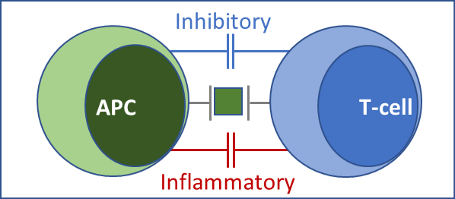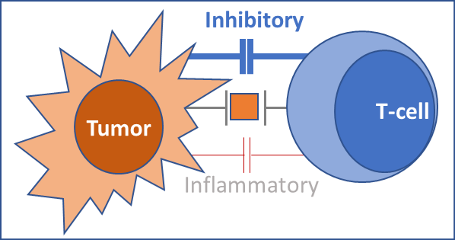Tumor Immunology
You are here
- Upon antigen recognition by an immune cell, the IMMUNE RESPONSE to a foreign antigen is shaped by the balance between inflammatory and inhibitory co-stimulation (Fig. 1).
- The anti-tumor response requires that a tumor cell be recognized as foreign, or immunogenic (antigenic).
- Anti-tumor activity also requires T-cells to launch a cytotoxic immune response toward tumor cells. Prior chemotherapy may result in T-cell exhaustion and limit T-cell response.
- Tumor cells send predominantly inhibitory signals to T-cells. As a result, T-cells can no longer ‘see’ the tumor cell (Fig. 2).

Fig 1. IMMUNE RESPONSE Antigen presenting cells (APC) present antigen to T-cells. Simultaneously, inflammatory and inhibitory costimulatory signals are generated by respective receptor-ligand combinations, which serve as immune checkpoints. The final immune response, whether cytotoxic (inflammatory), or suppressive (inhibitory), represents a balance between the two.

Fig 2. TUMOR DEFENSE AGAINST IMMUNE RESPONSE: Tumors overexpress inhibitory costimulatory proteins, such as PD-L1. Inhibitory signals are communicated to T-cells via complementary T-cell-bound receptors such as PD-1. As a result, inhibitory signaling to T-cells is enhanced. Inflammatory signals are overwhelmed. The tumor escapes immune attack.
